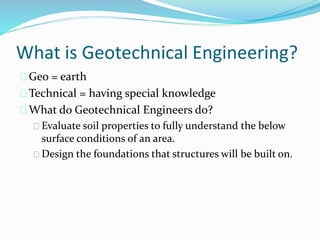Geotheta Fundamentals Explained
Geotheta Fundamentals Explained
Blog Article
Little Known Questions About Geotheta.
Table of Contents7 Easy Facts About Geotheta DescribedWhat Does Geotheta Do?Our Geotheta IdeasFascination About GeothetaThe 7-Second Trick For Geotheta

They perform website investigations, gather examples, perform laboratory examinations, and analyze information to review the suitability of the ground for construction tasks - Consulting Engineers. Based upon their findings, geotechnical engineers give suggestions for foundation layout, incline security, keeping structures, and reduction of geotechnical dangers. They collaborate with various other professionals, such as designers, structural designers, and building groups, to make certain that geotechnical factors to consider are incorporated into the total project layout and application
By analyzing the behavior and buildings of soil and rock, they can recognize potential geotechnical hazards such as landslides, dirt settlement, or incline instability. Their know-how helps protect against failures or mishaps that could jeopardize lives and property. Right here are some in-depth duties and obligations of a geotechnical designer: Website Investigation: Geotechnical designers conduct site investigations to collect information on subsurface conditions.
They translate the data to understand the residential properties and behavior of the dirt and rock, including their stamina, leaks in the structure, compaction characteristics, and groundwater problems. Geotechnical Analysis and Style: Geotechnical engineers analyze the information gathered throughout website investigations to examine the stability and suitability of the site for building and construction projects. They perform geotechnical computations and modeling to examine elements such as birthing capacity, negotiation, slope stability, lateral earth pressures, and groundwater circulation.
A Biased View of Geotheta
Foundation Design: Geotechnical designers play an important role in making foundations that can securely support the designated framework. They assess the soil conditions and load requirements to determine the ideal foundation type, such as superficial structures (e.g., grounds), deep structures (e.g (https://www.metal-archives.com/users/geotheta)., stacks), or specialized strategies like soil renovation. They consider factors such as settlement limits, bearing ability, and soil-structure communication to develop ideal foundation styles
They assess building and construction plans, screen website tasks, and carry out field inspections to confirm that the layout suggestions are complied with. If unanticipated geotechnical concerns emerge, they examine the scenario and supply recommendations for remediation or modifications to the layout. Danger Assessment and Reduction: Geotechnical engineers assess geotechnical hazards and dangers connected with the job website, such as landslides, liquefaction, or soil disintegration.

Collaboration and Communication: Geotechnical designers function very closely with various other experts included in a job, such as designers, architectural designers, and building teams. Effective interaction and cooperation are vital to incorporate geotechnical factors to consider into the general project design and building and construction procedure. Geotechnical engineers offer technical competence, solution questions, and make certain that geotechnical requirements are met.
About Geotheta
Here are some sorts of geotechnical engineers: Foundation Designer: Foundation engineers concentrate on designing and assessing foundations for structures. They assess the dirt conditions, tons needs, and site qualities to identify one of the most proper structure kind and style, such as superficial structures, deep structures, or specialized techniques like heap foundations.
They evaluate the factors affecting slope security, such as soil properties, groundwater problems, and incline geometry, and establish strategies to stop slope failings and alleviate dangers. Quake Designer: Quake designers focus on analyzing and creating structures to hold up against seismic pressures. They assess the seismic danger of a site, evaluate soil liquefaction possibility, and develop seismic style criteria to guarantee the safety and strength of frameworks during earthquakes.
They perform field testing, collect examples, and analyze the accumulated data to identify the soil properties, geologic developments, and groundwater problems at a site. Geotechnical Instrumentation Designer: Geotechnical instrumentation designers concentrate on tracking and determining the habits of soil, rock, and structures. They install and maintain instrumentation systems that check elements such as dirt settlement, groundwater levels, incline activities, and structural variations to evaluate efficiency and offer very early warnings of potential issues.
All About Geotheta
They conduct tests such as triaxial examinations, combination tests, straight shear tests, and permeability examinations to collect information for geotechnical evaluation and layout. Geosynthetics Designer: Geosynthetics designers concentrate on the design and application of geosynthetic products, such as geotextiles, geogrids, and geomembranes. They make use go to this web-site of these materials to enhance soil stability, enhance slopes, supply drainage remedies, and control disintegration.
They often tend to be investigatory people, which means they're intellectual, reflective, and analytical. They are curious, methodical, reasonable, analytical, and rational. Some of them are additionally social, meaning they're kind, charitable, cooperative, client, caring, practical, understanding, skillful, and friendly - Tailings Engineer.
In the office environment, geotechnical engineers make use of specialized software devices to do computations, produce layouts, and analyze data. They prepare records, evaluation project specs, communicate with clients and employee, and coordinate job activities. The office setting provides a helpful setting for study, evaluation, and cooperation with various other experts entailed in the job.
Top Guidelines Of Geotheta
They frequently check out project websites to carry out site examinations, evaluate geotechnical problems, and gather data for evaluation. These brows through entail traveling to various places, in some cases in remote or tough terrains. Geotechnical engineers might perform soil tasting, conduct examinations, and display construction activities to ensure that the geotechnical elements of the project are being carried out correctly.
Geotechnical designers additionally function in specialized geotechnical research laboratories. In these facilities, they conduct experiments, execute examinations on dirt and rock examples, and evaluate the design properties of the products. Geotechnical laboratory engineers work thoroughly in these environments, dealing with screening tools, running instruments, and tape-recording information. They team up with various other lab staff to ensure accurate and trusted testing results.
Report this page